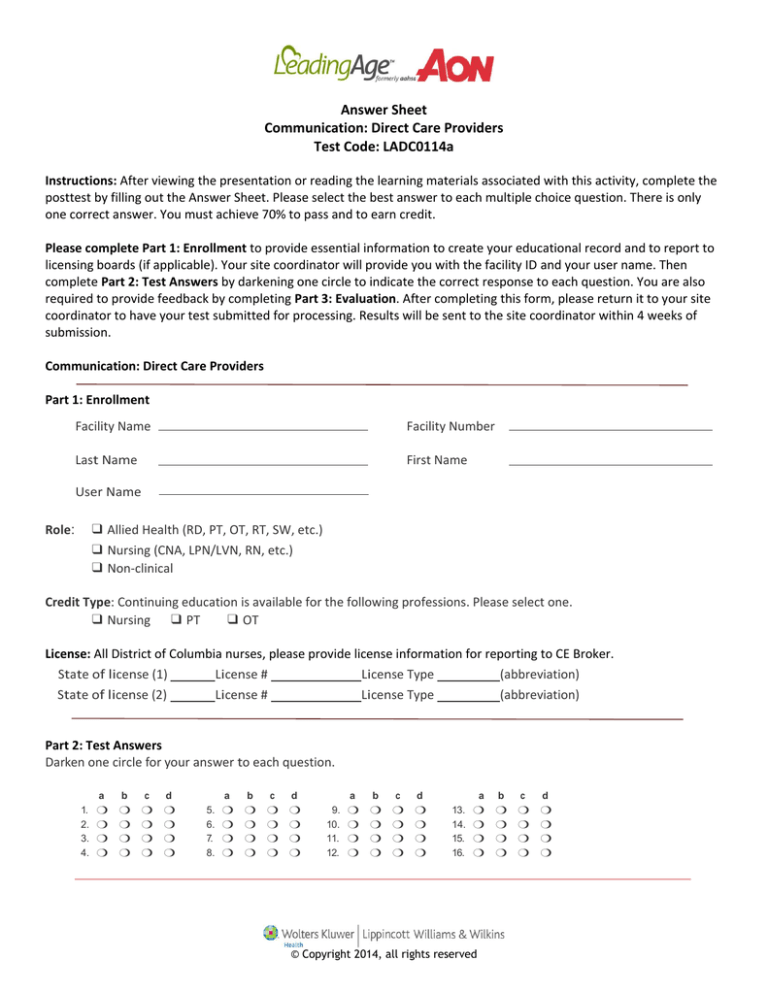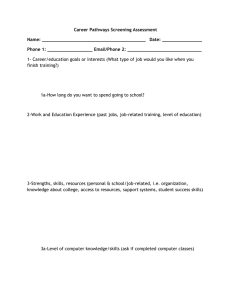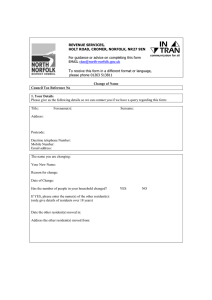
Answer Sheet
Communication: Direct Care Providers
Test Code: LADC0114a
Instructions: After viewing the presentation or reading the learning materials associated with this activity, complete the
posttest by filling out the Answer Sheet. Please select the best answer to each multiple choice question. There is only
one correct answer. You must achieve 70% to pass and to earn credit.
Please complete Part 1: Enrollment to provide essential information to create your educational record and to report to
licensing boards (if applicable). Your site coordinator will provide you with the facility ID and your user name. Then
complete Part 2: Test Answers by darkening one circle to indicate the correct response to each question. You are also
required to provide feedback by completing Part 3: Evaluation. After completing this form, please return it to your site
coordinator to have your test submitted for processing. Results will be sent to the site coordinator within 4 weeks of
submission.
Communication: Direct Care Providers
Part 1: Enrollment
Facility Name
Facility Number
Last Name
First Name
User Name
❑ Allied Health (RD, PT, OT, RT, SW, etc.)
❑ Nursing (CNA, LPN/LVN, RN, etc.)
❑ Non-clinical
Role:
Credit Type: Continuing education is available for the following professions. Please select one.
❑ Nursing ❑ PT
❑ OT
License: All District of Columbia nurses, please provide license information for reporting to CE Broker.
State of license (1)
License #
License Type
(abbreviation)
State of license (2)
License #
License Type
(abbreviation)
Part 2: Test Answers
Darken one circle for your answer to each question.
1.
2.
3.
4.
a
b
c
d
❍
❍
❍
❍
❍
❍
❍
❍
❍
❍
❍
❍
❍
❍
❍
❍
5.
6.
7.
8.
a
b
c
d
❍
❍
❍
❍
❍
❍
❍
❍
❍
❍
❍
❍
❍
❍
❍
❍
9.
10.
11.
12.
a
b
c
d
❍
❍
❍
❍
❍
❍
❍
❍
❍
❍
❍
❍
❍
❍
❍
❍
13.
14.
15.
16.
a
b
c
d
❍
❍
❍
❍
❍
❍
❍
❍
❍
❍
❍
❍
❍
❍
❍
❍
© Copyright 2014, all rights reserved
Part 3: Course Evaluation
1. Rate to what extent you were able to meet
Objective 1: Identify errors in communication that can
increase exposure for lawsuits. (1- lowest, 5- highest)
1
2
3
4
5
2. Rate to what extent you were able to meet
Objective 2: Choose more effective communication
techniques in order to provide quality services and
avoid malpractice incidents or lawsuits. (1- lowest,
5- highest)
1
2
3
4
5
3. Was evidence provided to substantiate material
presented?
Yes
No
4. Were personal experience and observation the
primary source of information?
Yes
No
9. Rate the degree that you believe this course was
objective and free from bias. (1, lowest, 5- highest)
1
2
3
4
5
10. Was a commercial product promoted?
Yes
No
11. If yes, did you feel that product promotion was the
sole purpose of the course?
Yes
No
12. Rate your level of expertise in this subject prior to
this course. (1- lowest, 5- highest)
1
2
3
4
5
13. Rate the educational level of the content.
Basic
Intermediate
Advanced
5. Rate to what extent did the program content relate
to the learning objectives? (1 lowest, 5- highest)
1
2
3
4
5
14. Comments:
6. Rate the effectiveness of the independent study
learning method. (1- lowest, 5- highest)
1
2
3
4
5
15. What future topics would you like to see offered for
continuing education?
7. Rate the contribution of this course to your overall
knowledge of the subject. (1, lowest, 5- highest)
1
2
3
4
5
8. Rate your overall degree of satisfaction with this
course. (1- lowest, 5- highest)
1
2
3
4
5
© Copyright 2014, all rights reserved
Communication: Direct Care Provider
Posttest
— Retain test below for your records. Only submit answer sheet and evaluation for processing —
General Purpose: To provide direct care personnel with information about strategies to reduce high-risk liability
occurrences in long-term care facilities.
Learning Objectives:
After completing this educational activity and taking the post-test, you should be able to:
1. Identify errors in communication that can increase exposure for lawsuits.
2. Choose more effective communication techniques in order to provide quality services and avoid malpractice
incidents or lawsuits.
1. The four C's of Communication are
A. Clear, Concise, Clinical, Complete.
B. Complete, Case-by-case, Concise, Correct.
C. Clear, Concise, Correct, Complete.
D. Concise, Consent, Correct, Complete.
2. All of the following can be barriers to effective communication except
A. generational differences.
B. educational level.
C. large team size.
D. collaboration.
3. Nonverbal behavior when engaging in healthcare communication includes
A. posture.
B. tone of voice.
C. facial expression.
D. all of the above.
4. Some telephone risk reduction tips include all of the following except
A. designate a separate telephone conversation area.
B. use landlines when possible.
C. only leave sensitive information on an answering machine, in a voicemail message, or with an answering service
if the resident has provided you with that specific phone number.
D. update resident telephone numbers on a regular basis.
5. Which of the following can assist in overcoming communication barriers in the workplace?
A. Sharing knowledge
B. Collegial relationships
C. Understanding differences
D. All of the above
© Copyright 2014, all rights reserved
6. Working to increase effective communication can lead to
A. improved quality of care.
B. a decrease in resident safety.
C. lack of team cohesiveness.
D. decreased nurse satisfaction.
7. The hand over process includes passing information from one caregiver to another. This information includes
A. services delivered to the resident.
B. resident's condition.
C. resident's care, treatment, and anticipated changes.
D. all of the above.
8. Which of the following is not true about generational differences in the workplace?
A. It is highly probable that a workplace could have up to 4 different generations working closely together.
B. Generational differences can result in frequent misunderstandings and misconceptions.
C. Recognizing the variation in generational perspective is a tool to improve communication.
D. Although different generations vary in age, they all approach their job in the same manner.
9. Which of the following would be considered a hand off point?
A. Lunch time
B. Nursing shift changes
C. Transfer from the emergency department to an in-patient setting
D. All of the above
10. Informed consent is
A. the voluntary permission that a resident or resident's legal representative gives to the physician or authorized
healthcare provider to do something to or for that resident after having been apprised of the risks, benefits and
alternatives to the proposed test, medication or treatment.
B. the exchange of information, ideas, or opinions.
C. a barrier to effective communication.
D. a HIPAA violation.
© Copyright 2014, all rights reserved


